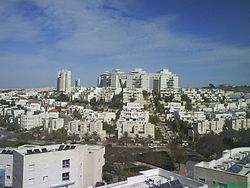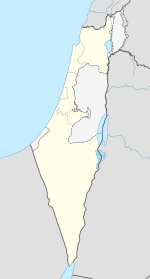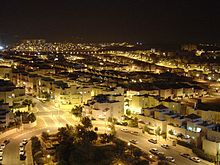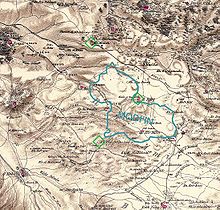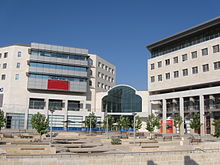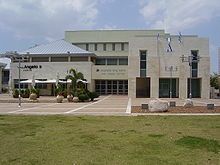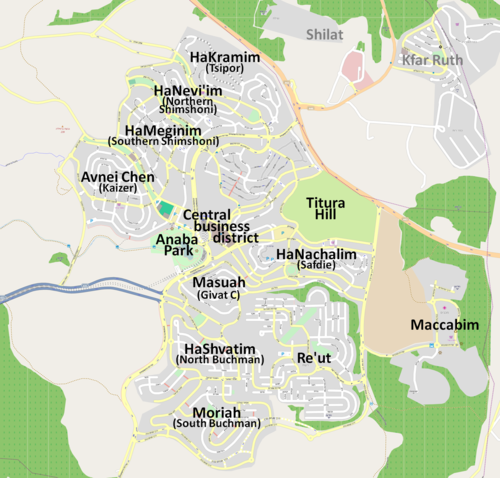- Modi'in-Maccabim-Re'ut
-
"Modiin" redirects here. For the company, see Modiin Energy.
Modi'in-Maccabim-Re'ut Hebrew transcription(s) – Hebrew מוֹדִיעִין-מַכַּבִּים-רֵעוּת 
LogoLocation within Israel Coordinates: 31°54′27.55″N 35°0′27.41″E / 31.9076528°N 35.0076139°ECoordinates: 31°54′27.55″N 35°0′27.41″E / 31.9076528°N 35.0076139°E District Center Founded 2003 (merger)
1993 (Modi'in)
1985 (Maccabim)
1987 (Re'ut)Government – Type City (from 2003) – Mayor Haim Beebas Area – Total 50,176 dunams (50.2 km2 / 19.4 sq mi) Population (2010)[1] – Total 74,300 Website http://www.modiin.muni.il Modi'in-Maccabim-Re'ut (Hebrew: מוֹדִיעִין-מַכַּבִּים-רֵעוּת) is a city in the Center District of Israel located approximately halfway between Jerusalem and Tel Aviv. It was formed in 2003 by the merger of Modi'in and Maccabim-Re'ut. According to the Israel Central Bureau of Statistics, the city's 2010 population was 74,300.[1]
Contents
Etymology
The name "Modi'in" derives from the village "Modi'im" of the high priest Mattathias and his five sons, which was located in the same area as the modern city. The name "Maccabim" is Hebrew for the Maccabees, and is a common nickname given to Mattathias and his five sons.
History
Modi'in
Ancient Modi'in was the place of origin of the Jewish Hasmonean dynasty that ruled Judea in the 1st and 2nd centuries BCE, and it is where the Maccabean revolt against the Seleucid Greeks started.
Modern Modi'in is located near the site of the ancient Modi'in described in the Talmud, though the specific location is uncertain. Possibilities are Suba, Umm el-'Umdan near Route 20 to Canada Park and Latrun, Khirbet el-Midye, and Khirbet el-Burj (Titura).[2][3][4] The cornerstone for present-day Modi'in was laid in 1993. It is a modern planned city with high standards of urban planning. Environmental issues and future growth were taken into consideration from the early design stages. Large greenspaces were incorporated into the city's layout and comprise 50% of the area within the city limits. The long term projection of the ministry of housing is for the city to be home to 240,000 residents, thus becoming one of the largest localities in Israel. However, plans approved for the city thus far are for only 120,000 residents.
Modi'in has become a magnet for secular residents leaving Jerusalem because of the growing Haredi population there.[5] Thousands of residents of Rosh HaAyin, Lod, and Ramla have also relocated to Modi'in. Some in those cities see Modi'in's rapid growth as a threat to the well-being of their cities, with some even suggesting that the city's very establishment was a mistake.[5] This led to a decision in 2008 to put a cap on Modi'in's growth, allowing it in the short term to expand only to a population of 120,000,[5] rather than the original plans for 240,000, in order to better conditions in Lod-Ramla 12 kilometers to the west.[5] These plans however have been contested by the city's government, which has plans to turn Modi'in into one of the nation's largest cities.[5] The city also attracts Olim from English speaking countries.[6]
The city was planned by the well-known architect Moshe Safdie. Its design was supervised by the Ministry of Housing and Construction's main architect Carlos Drinberg and the City Engineer-Architect Daniel Senerman.[citation needed]
Maccabim-Re'ut
The project of founding Maccabim in 1985 was led by the International Maccabi organisation; the project of founding nearby Re'ut in 1987 was led by an association of Israel's Standing Army officers. The towns were united into Maccabim-Re'ut in 1990.
Geography
Modi'in is located about 35 kilometres (22 mi) southeast of Tel Aviv and 30 kilometres (19 mi) west of Jerusalem, and is connected to the two via Highway 443. Its physical geography: Climate, landforms, flora and fauna, all reflect this position midway between the two cities.
Demographics
According to the Israel Central Bureau of Statistics, the City is rated at level 8 out of 10 on the scale of socio-economic development, with a high proportion of high school graduation, 76.5% (2006–07), and an average monthly income of 9,659 NIS, compared to a national average of 7,466 (2006).
Neighborhoods
HaShvatim (North Buchman/Buchman) and Moriah (South Buchman) are the most southern neighborhoods in the city. Most of the buildings in this neighborhood are ground-level private homes and condos. The streets of Shvatim are named after the tribes of Israel, and the streets of Moriah are named after ancient historical Jewish figures. Moriah, the name of the southern neighborhood, is also a feminine name representing these women.
HaPrachim (Miromi) is a small neighborhood in the city center. Located in HaPrachim is a commercial center, two primary schools and a secondary school. The neighborhood's streets are named after trees, flowers, and plants. At the northern part of the neighborhood there is a small compound where the streets are named after phrases from the Song of Songs.
HaNachlim (Safdie) and Masuah (Givat C) are located towards the west of the city, and were planned by architect Moshe Safdie. Located in these neighborhoods are five commercial centers, a secondary school and three primary schools. The central street names are named after valleys in Israel, and the side streets are named after Israeli rivers and streets. The name "Masuah" was selected in order to represent the neighborhood's high altitude. Within the area consisting of the streets named after rivers and streams is the "Malibu" area, which is named after the contractor who designed the neighborhood.
HaKramim (Tsipor) is the northernmost neighborhood in Modiin. The streets are named after the Hebrew months. The name "Kramim" is in honor of the vineyards that were located where the neighborhood now stands before the city was founded.
Avnei Chen (Kaizer) is located towards the west of the city, and parts of it are still under construction. The main road is named "Avnei Choshen" and leads to the only underground commercial center in Modi'in.
HaNevi'im (Northern Shimshoni) and HaMeginim (Southern Shimshoni) are located towards the northwest of the city. Located in the neighborhoods are three commercial centers, three primary schools, and one secondary school.
HaTsiporim (South Kaizer) is still being planned. Its streets will be named after different species of birds, and will be a relatively small neighborhood consisting of only seven streets.
Culture and sports
In 2007, Modi'in was selected as one of the inaugural cities for the Israel Baseball League. The baseball team was named the Modi'in Miracle, but did not play games in Modi'in as there is no baseball stadium there. In 2008, the Pioneers of the Israeli Football League (American Football) relocated to Modi'in. The Pioneers played all their home games in Modi'in. In their first year, the Modi'in "Dancing Camel" Pioneers won the IFL Championship. After an unsuccessful 2009-10 season, their second in Modi'in, the Pioneers relocated once again to Tel Aviv, where most of the team's players lived.
Transportation
Modi'in-Maccabim-Re'ut is accessible by Road 431, Highway 3 and Road 443.
An Israel Railways line began operation on April 1, 2008 to a large underground station in Modi'in. Service began in September 2007 to Paatei Modi'in on the western outskirts of the city. This railway connects Modi'in to Tel Aviv by way of Ben Gurion Airport. The line to Modi'in is a spur off the high-speed railway to Jerusalem, currently due for completion in 2016. Once this line is completed, Modi'in will be within 30 minutes' ride of Jerusalem.
Intercity and local bus services are provided by Veolia Transport Israel.
Notable residents
- Shahar Pe'er, tennis player
- Ben Sahar, association football player
- Yariv Levin, Knesset member
- Uri Orbakh, Knesset member
- Moshe Ya'alon, Knesset member, Vice Prime Minister, and Minister of Strategic Affairs
- Eyal Gabai, Director-General of Israel's Prime Minister's Office
- Mark Regev, prime minister's spokesman
- Alon Tal, environmental activist[citation needed]
Twin towns
 Hagen, Germany since 1997
Hagen, Germany since 1997 Banja Luka, Bosnia and Herzegovina since 2010
Banja Luka, Bosnia and Herzegovina since 2010 Rochester, New York, United States since 2003
Rochester, New York, United States since 2003
References
- ^ a b "Table 3 - Population of Localities Numbering Above 2,000 Residents and Other Rural Population". Israel Central Bureau of Statistics. 2010-06-30. http://www.cbs.gov.il/population/new_2010/table3.pdf. Retrieved 2010-10-30.
- ^ Shimon Gibson, ASOR Newsletter 49-1 (1999) pp. 16-17
- ^ Shlomit Weksler-Bdolah, ASOR conference 2003
- ^ Joshua Schwartz, Lod (Lydda), Israel: from its origins through the Byzantine period, 5600 B.C.E. - 640 C.E, Oxford University Press, 1991, pp. 61-63.
- ^ a b c d e Was building city of Modi'in a mistake?
- ^ "A gilded landsmanschaft - Israel Jewish Scene, Ynetnews". Ynetnews.com. 1995-06-20. http://www.ynetnews.com/articles/0,7340,L-4077093,00.html. Retrieved 2011-09-16.
External links
- Municipality of Modi'in - official web site (Hebrew)
- Modiinfo.com - your source for Modiin related information (English)
- Places to visit in Modi'in (English)
Old municipalities Baqa al-Gharbiyye · Bi'ina · Binyamina · Daliyat al-Karmel · Deir al-Asad · Giv'at Ada · Isfiya · Jat · Kadima · Maccabim-Re'ut · Majd al-Krum · Modi'in · Neve Monosson · Tzoran · Tzur Yigal · YehudCenter District of Israel Cities El'ad · Hod HaSharon · Kafr Qasim · Kfar Saba · Lod · Modi'in-Maccabim-Re'ut · Ness Ziona · Netanya · Petah Tikva · Qalansawe · Ra'anana · Ramla · Rehovot · Rishon LeZion · Rosh HaAyin · Tayibe · Tira · Yavne · Yehud-Monosson
Local councils Be'er Ya'akov · Beit Dagan · Bnei Ayish · Elyakhin · Even Yehuda · Gan Yavne · Ganei Tikva · Gedera · Jaljulia · Kafr Bara · Kfar Yona · Kiryat Ekron · Kokhav Ya'ir · Mazkeret Batya · Pardesiya · Savyon · Shoham · Tel Mond · Tzoran-Kadima · ZemerRegional councils Brenner · Gan Raveh · Gederot · Gezer · Drom HaSharon · Hefer Valley · Hevel Modi'in · Hevel Yavne · Hof HaSharon · Lev HaSharon · Lod Valley · Nahal SorekBoroughs See also Other sub-divisions: Haifa District · Jerusalem District · Judea and Samaria Area · North District · South District · Tel Aviv DistrictIsraeli cities with a 50,000+ population 500,000+ 200,000 – 499,999 100,000 – 199,999 50,000 – 99,999 Herzliya • Kfar Saba • Ra'anana • Hadera • Beit Shemesh • Modi'in-Maccabim-Re'ut • Lod • Nazareth • Ramla • Giv'atayim • Rahat • Nahariya • Kiryat AtaCategories:- Center District (Israel)
- Cities in Israel
- Modi'in
Wikimedia Foundation. 2010.

